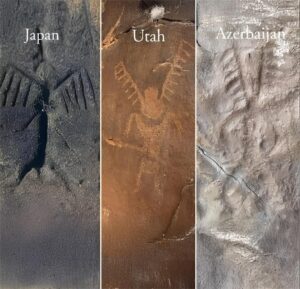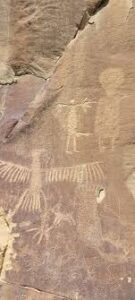Uncovering a Shared Ancient Mystery
In distant corners of the world, from the rugged landscapes of Utah to the ancient caves of Japan and the windswept plains of Azerbaijan, petroglyphs—rock carvings created by ancient peoples—have been discovered. What’s astonishing is that these carvings share remarkable similarities despite vast geographic and cultural distances. Each of these sites contains depictions of winged or flying human figures, hinting at a shared mythological or symbolic language that transcends both time and space.
This discovery raises questions that resonate deeply: Were these symbols born of common beliefs about celestial beings? Did ancient civilizations somehow share cultural connections, or are the similarities in their art coincidental? Let’s explore these petroglyphs to understand their origins, meanings, and the broader implications they hold for our understanding of early human thought.
The Locations of Discovery: Japan, Utah, and Azerbaijan
Fugoppe Cave, Japan
Nestled in the northern part of Japan, Fugoppe Cave houses some of the oldest petroglyphs in the region, dating back approximately 7,000 years. These carvings include symbols and figures, some of which are distinctly winged or appear to be hovering. For ancient Japanese cultures, these depictions may have symbolized spiritual or mythological beliefs about beings who could traverse between the earthly and celestial realms.
Nine Mile Canyon, Utah, USA
Nine Mile Canyon in Utah, sometimes referred to as the “world’s longest art gallery,” is home to petroglyphs dating from around 1,000 to 2,000 years ago. While not as ancient as Fugoppe Cave, these petroglyphs share similar motifs, including depictions of human figures with wings. In the traditions of the Native American tribes who created these carvings, such figures may represent shamanic journeys, spirit beings, or mythological figures with special powers.
Gobustan, Azerbaijan
Azerbaijan’s Gobustan region holds some of the most ancient petroglyphs known to humanity, with some carvings estimated to be around 10,000 years old. The region is a UNESCO World Heritage site, rich with petroglyphs that depict everything from animals and hunting scenes to enigmatic human figures with wings. The age and sophistication of Gobustan’s carvings suggest that early humans here had a developed symbolic language, possibly including beliefs about spirits or deities from the sky.

The Significance of Winged or Flying Figures
The recurring motif of winged or flying human figures raises intriguing questions. In each of these regions, ancient cultures seemed captivated by beings associated with flight or celestial travel. Scholars and archaeologists propose several interpretations for these figures:
- Celestial Beings or Deities: In many ancient mythologies, winged beings are seen as messengers or deities from the heavens. The resemblance in these petroglyphs may indicate shared beliefs about divine beings who could move between the earth and the heavens.
- Shamanic Journeys: Shamanism was common among ancient societies and often involved rituals that mimicked flight, symbolizing a journey to the spirit world. Winged figures might represent shamans or spirit guides, conveying the role of these intermediaries between the human and spiritual realms.
- Mythological Archetypes: Some theorists suggest that the reappearance of certain symbols in separate societies could indicate universal archetypes, ideas that naturally arise in the human mind regardless of culture. Winged humans could reflect an archetype of spiritual ascent, freedom, or transcendence, common to all humanity.

A Shared Belief or a Remarkable Coincidence?
The similarities among these petroglyphs prompt an essential question: do these images signify cultural connections between early civilizations, or are they coincidental?
Evidence of Cross-Cultural Exchanges
Some scholars argue that ancient societies were more interconnected than we typically assume. Trade routes, migration, and even sporadic interactions across vast distances might have led to a shared cultural language. For example, ancient trade routes connected Asia, Europe, and the Middle East, allowing for an exchange of ideas, beliefs, and symbols that could explain similarities in petroglyphs.
Independent Development of Similar Ideas
Another perspective is that these figures reflect independently developed ideas that naturally arose within each culture. Humans across the globe have shared existential questions about the heavens, spirits, and the unknown. It’s possible that these petroglyphs represent a common human impulse to depict spiritual beliefs and create symbols related to celestial realms.
The Legacy and Lessons of Ancient Petroglyphs
Petroglyphs like those in Japan, Utah, and Azerbaijan are not merely ancient artifacts; they offer a portal into the minds and beliefs of early humans. These carvings are powerful reminders of humanity’s long-standing fascination with the heavens and the mysteries of existence. The repeated theme of winged figures suggests that our ancestors, regardless of their location, shared a deep-seated curiosity about forces beyond the tangible world.

Decoding Our Shared Humanity
As we examine these ancient symbols, they urge us to consider what they reveal about the common threads in human thought. By analyzing petroglyphs and their potential meanings, archaeologists and anthropologists continue to uncover insights into the shared dreams, fears, and hopes of our distant ancestors. These ancient carvings remind us that, despite our differences, there are profound ways in which all human cultures connect.
